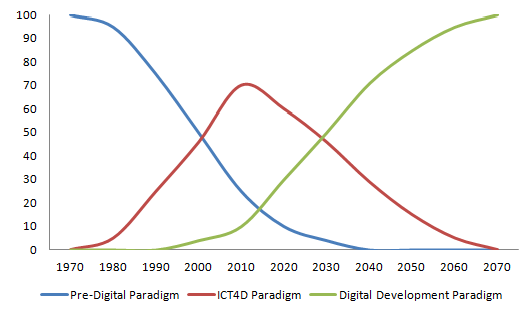Taking a longer-term view, the relationship between digital ICTs and international development can be divided into three paradigms – “pre-digital”, “ICT4D”, and “digital development” – that rise and fall over time (see Figure below).
The pre-digital paradigm dominated from the mid-1940s to mid-1990s, and conceptualised a separation between digital ICTs and development [1]. During this period, digital ICTs were increasingly available but they were initially ignored by the development mainstream. When, later, digital technologies began to diffuse into developing countries, they were still isolated from the development mainstream. ICTs were used to support the internal processes of large public and private organisations, or to create elite IT sector jobs in a few countries. But they did not touch the lives of the great majority of those living in the global South.
The ICT4D paradigm has emerged since the mid-1990s, and conceptualised digital ICTs as a useful tool for development [2]. The paradigm arose because of the rough synchrony between general availability of the Internet – a tool in search of purposes, and the Millennium Development Goals – a purpose in search of tools. ICTs were initially idolised as the tool for delivery of development but later began to be integrated more into development plans and projects as a tool for delivery of development.
The isolationism of the pre-digital paradigm remains present: we still find policy content and policy structures that segregate ICTs. But integrationism is progressing, mainstreaming ICTs as a tool to achieve the various development goals. From the development side, we see this expressed in national policy portfolios, in Poverty Reduction Strategy Papers, in UN Development Assistance Frameworks. From the ICT side, we see this expressed in national ICT policies and World Summit on the Information Society action lines.
The ICT4D paradigm is currently dominant and will be for some years to come. Yet just at the moment when it is starting to be widely adopted within national and international development systems, a new form is hoving into view: a digital development paradigm which conceptualises ICT not as one tool among many that enables particular aspects of development, but as the platform that increasingly mediates development.
This is the subject of a Development Informatics working paper: “Examining “Digital Development”: The Shape of Things to Come?”, and will be the topic for future blog entries.
[1] Heeks, R. (2009) The ICT4D 2.0 Manifesto: Where Next for ICTs and International Development?, Development Informatics Working Paper no.42, IDPM, University of Manchester, UK
[2] ibid.


